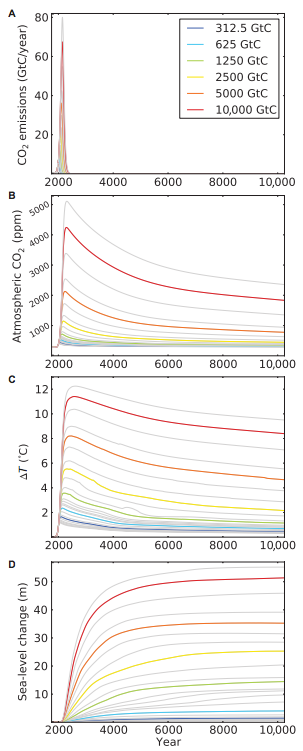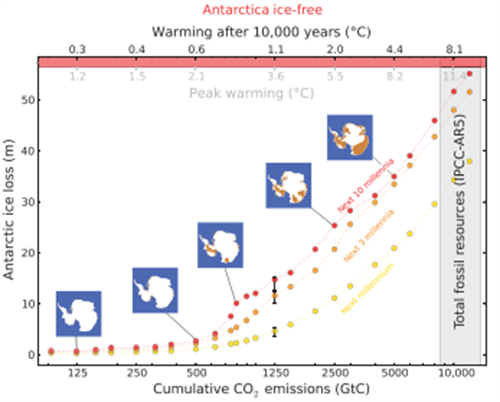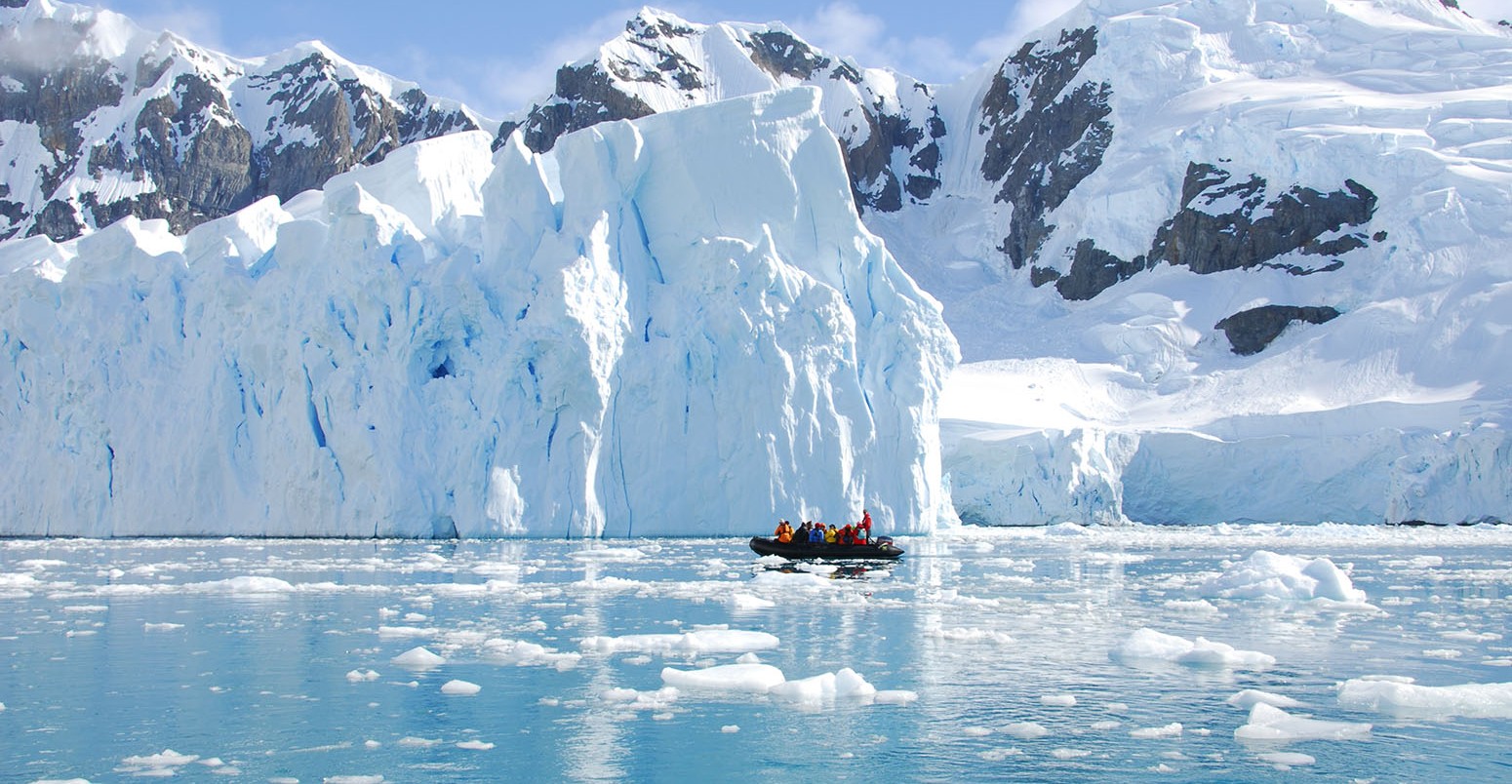Keep coal, gas and oil in the ground to save Antarctic ice sheet, study warns
Multiple Authors
09.11.15Multiple Authors
11.09.2015 | 7:00pmThere are enough fossil fuels buried in the ground to melt the whole of the Antarctic ice sheet – should we choose to burn them, according to new research.
Though it may take thousands of years, that future would see sea level rise by more than 50 metres – inundating cities from London to Barcelona and Tokyo to Washington D.C.
This “mind boggling” finding shows that our actions now have the power to change the face of the planet for tens of thousands of years to come, lead author Dr Ricarda Winkelmann, from the Potsdam Institute for Climate Impact Research, tells Carbon Brief. She says:
“To put it bluntly: if we burn it all, we melt it all.”
58 metres
The Antarctic ice sheet is the largest mass of ice on our planet, a white blanket spreading out over 14m square kilometers of the continent.
Global temperature rise, driven by global greenhouse gas emissions, is causing parts of the ice sheet to melt and become unstable. According to NASA, Antarctica has lost an average of 118bn tonnes of ice per year since 2004.
As the majority of the ice sheet sits on land, melting ice adds to global sea levels. At the moment, melting of Antarctic ice contributes 0.4mm to global sea levels each year, but such is the size of Antarctica, there’s enough ice on it to raise sea levels by 58 metres.
The new study, published in Science Advances, warns that burning all our remaining fossil fuel resources now could commit us to enough warming to melt the entire ice sheet.
This is a stark illustration that what happens thousands of years from now is intimately tied to the actions we take now, the authors explain.
12,000 billion tonnes
The researchers use an ice sheet model to test how Antarctica responds to increases in the total amount of carbon dioxide in the atmosphere.
They looked at what happened if different amounts of carbon get added to the atmosphere compared to 2010 levels, from an extra 100bn tonnes right up to 12,000bn tonnes.
The lower bound is a very optimistic situation where only a very small fraction of known resources are exploited. The upper bound is scientists’ estimate of the total amount of coal, oil and gas exists across the world and can potentially be extracted.

Temperature and sea level rise as a result of different emissions scenarios. Total emissions of 10,000bn tonnes (red) lead to global temperature rise of more than 10C and sea level rise approaching 50m, compared to 2010 levels. Source: Winkelmann et al., (2015)
In any scenario, the release of emissions from fossil fuel burning takes no more than 500 years. But the concentration of carbon dioxide in the atmosphere stays high for a long time after the last fossil fuels are burned and global temperature, in turn, stays high for many thousands of years. Winkelmann explains to Carbon Brief:
“This means that even 10,000 years into the future it would still be several degrees warmer on average than it is today if we were to burn all the fossil fuel resources.”
Ice-free
These high temperatures speed up ice loss on Antarctica, mainly as warmer water melts the ice shelves that extend out from the continent over the ocean from the bottom up. This, in turn, sets off a process that further accelerates melting, the paper explains:
“Once a critical temperature is reached, a second self-reinforcing feedback kicks in and destabilizes the remaining ice.”
Over thousands of years, large parts of the ice sheet melt or drain into the ocean, raising global sea level by several tens of metres, the paper says.
The most vulnerable region to ice loss is the West Antarctic ice sheet, which becomes unstable with 600-800bn extra tonnes of carbon in the atmosphere. Recent research shows glaciers there may have already tipped into unstoppable ice loss, the paper explains.
If total emissions reached 10,000bn tonnes above 2010 levels, Antarctica would become almost ice-free, raising sea levels by three metres per century over the first 1,000 years.
With unrestrained emissions, sea-level rise from Antarctica could exceed 50 meters over the next 1,000 years and could ultimately lead to the loss of the entire ice sheet. The changes won’t be quick, but they will be serious, Winkelmann tells Carbon Brief:
“The changes we are looking at in our study do not happen overnight, but – as we’re saying in the press release – the mind boggling point is that our actions today – within just a few decades – are changing the face of planet Earth as we know it and will continue to do so for tens of thousands of years to come.”
Prof Ted Scambos, senior scientist at the US National Snow and Ice Data Center, who wasn’t involved in the study, tells Carbon Brief why policymakers should sit up and take notice of the study:
“It shows that in the next two centuries or so, we could commit ourselves to truly disastrous sea level rise, as well as many other climate impacts, if we continue on our present course.”

Sea level rise after 1000 (yellow), 3,000 (orange) and 10,000 (red) years for each of the study scenarios. If all currently attainable fossil fuel resources are burned [~ 12,000 gigatonnes (Gt)], the Antarctic ice sheet would virtually disappear, raising sea levels by 50 metres. Source: Winkelmann et al., (2015 )
Use it and lose it
Limiting global temperature rise to 2C above pre-industrial levels, the internationally accepted target, would result in a very different future. The paper explains:
“If the 2C target, corresponding to about 600 [billion tonnes] of additional carbon release compared to year 2010, were attained, the millennial sea-level rise from Antarctica could likely be restricted to 2 metres.”
As Winkelmann points out, we are not currently on course to meet the 2C target. She tells Carbon Brief:
“We have already used two thirds of the carbon dioxide emission budget consistent with the 2C target, and emissions are currently increasing from year to year…Policy decisions now could determine how coastlines might be reshaped in the future.”
Or to put it another way, she says:
“If we want to avoid Antarctica to become ice-free, we need to keep coal, gas and oil in the ground.”
Image: Iceberg off the coast of Antarctica. Credit: © Matt Berger/Shutterstock.com.
Winkelmann, R. et al. (2015) Combustion of available fossil fuel resources sufficient to eliminate the Antarctic ice sheet, Science Advances, doi:1/8/e1500589
-
There are enough fossil fuels buried in the ground to melt the whole of the Antarctic ice sheet - should we choose to burn them


